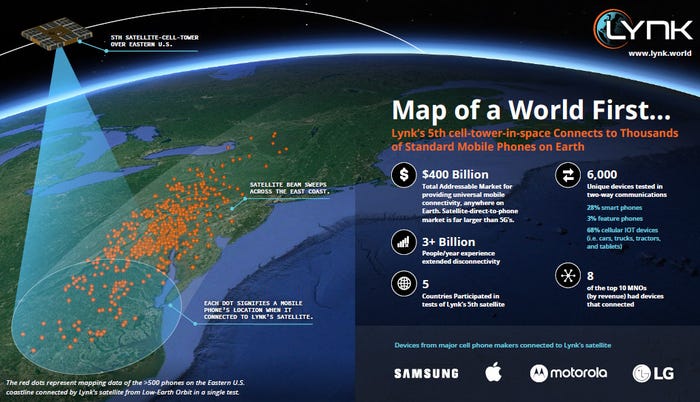Lynk launches ‘first commercial-ready cell-tower-in-space’
Satellite base-station company Lynk says it has successfully deployed Lynk Tower 1 into space, its first spacecraft covered by an FCC license to operate a satellite direct-to-standard-phone service.
April 6, 2022

Satellite base-station company Lynk says it has successfully deployed Lynk Tower 1 into space, its first spacecraft covered by an FCC license to operate a satellite direct-to-phone service.
Lynk Tower 1 is the firm’s sixth satellite which it says is now ‘in a position’ to be the world’s first commercial cell tower in space. It is an upgrade to the firm’s last iteration which last year was launched and connected ‘thousands of unique devices’ – which includes phones, IoT devices, and tablets.
Apparently this latest satellite has significant improvements on the last, with upgrades to the power systems, reaction wheels, star trackers, Ka-band radios, and the cell tower base station software stack.
“With the launch of Lynk Tower 1, Lynk is positioned to begin commercial service later this year and provides the world’s first true satellite-direct-to-phone service to citizens across the globe,” said Charles Miller, CEO and co-founder of Lynk. “For our flagship carrier partners, today’s news means that we are only months away from helping them solve the world’s ‘0G Problem’ and enabling their subscribers to connect everywhere.”
Tyghe Speidel, CTO and co-founder of Lynk added: “Most companies take years to design and test new spacecraft concepts. Lynk’s spacecraft development process leverages a rapid-do-learn-loop strategy where we quickly iterate and fly new spacecraft technologies several times a year. We learned a ton from our fifth satellite in late 2021. Those lessons have already been implemented in our sixth satellite. Many told us this was impossible. It’s not. This technology is now very real, with three more satellites launching in the next six months as we roll out initial commercial services.”
Lynk claims that 10% of the world’s surface is covered by terrestrial based mobile connectivity, which means most of it is a ‘coverage black spot’, as it puts it. Of course a lot of this must be the ocean, and people are hardly likely to be bobbing about 900 miles off the coast in the Atlantic sea, tapping their phones and wondering why they can’t order a Deliveroo sandwich.
However it is Lynk’s assertion that over three billion people per year experience extended periods of dysconnectivity, and another billion people don’t have mobile coverage at all. That’s what this new ‘cell tower in space’ is supposed to solve.
The firm says Lynk Towers 2, 3, and 4 are under construction and will be launched later in the year. All four of them will apparently allow people to connect their phones via satellite using a commercial service provided by their operator, if a deal has been set up. Nine such contracts have been agreed so far, and Lynk says there are plans to begin a global commercial service in 2022 with a dozen operators.
We spoke to Miller at MWC in March, who told us that “By 2025 we’re going to have broadband everywhere to your phone – web, voice, data, continuous broadband data. And then within ten years, we’re going to have the fastest speeds in broadband possible to your phone from satellite. That’s our vision.” You can read the interview here.
Here’s a vid and an infographic.
Lynk Tower 1 Deployment.mp4 from Lynk on Vimeo.

Get the latest news straight to your inbox. Register for the Telecoms.com newsletter here.
About the Author(s)
You May Also Like








.png?width=300&auto=webp&quality=80&disable=upscale)


_1.jpg?width=300&auto=webp&quality=80&disable=upscale)


.png?width=800&auto=webp&quality=80&disable=upscale)